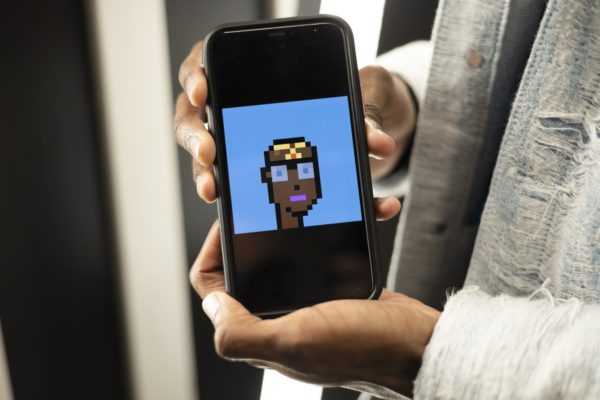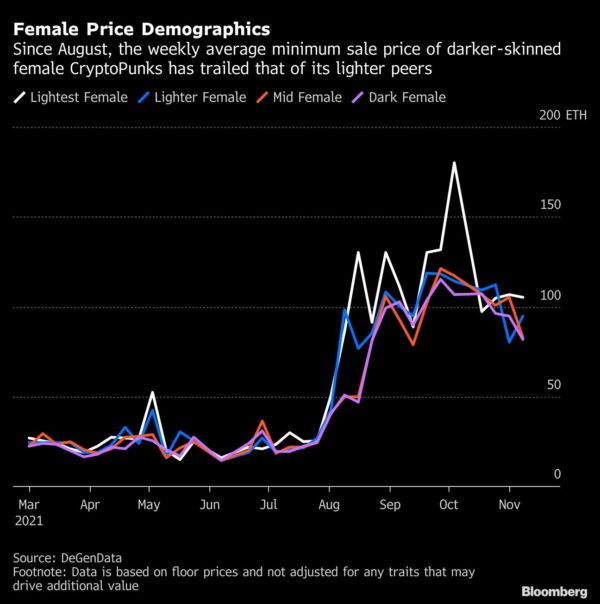By Misyrlena Egkolfopoulou and Akayla Gardner
The complexities of the real world are starting to bleed into the Metaverse — the virtual arena where identity functions as both a reflection on and determinant of social capital.
Differences in prices for digital avatars based on race, gender and skin color are emerging among a popular collection of NFTs known as CryptoPunks, belying the utopian and egalitarian ideals touted by the closely connected world of crypto, decentralized finance, blockchain and non-fungible tokens.

According to both participants in and observers of the space, these price discrepancies are partly explained by the lack of diversity among the investors who favor these status assets. It’s a demographic that skews mostly male and White. Female CryptoPunks, and those with darker skin colorings, tend to sell for less than avatars with male traits or fair skin.
CryptoPunk investors say the price disparity is not a function of individual prejudice or racism, but of the fact that the people currently willing and able to pay top dollar for digital goods aren’t bidding on avatars that don’t look like them.
“If you look at the blockchain space, it largely tends to be white, it largely tends to be male,” said Tony Herrera, an immigrant activist in California who owns 60 CryptoPunks. “One Punk could be dark and one could be light, and the lighter one is going to be the more desirable.”
To understand the role identity plays in the virtual world, consider the case of Richerd Chan. The engineer and entrepreneur from Vancouver, Canada, wanted to cement his reputation as a crypto pioneer, and so he decided to purchase a digital avatar.

At a cost of more than $80,000, or 45 ETH in crypto terms, that JPEG file would become his biggest-ever single expense. Chan spent two weeks on the hunt for what would come to represent his perfect online persona. On March 31, he clicked the buy button on a pixelated image of a medium-skin colored male avatar sporting 3D glasses and a cigarette.
“It’s a very natural representation of myself,” Chan, 37, said. “The 3D glasses make it stand out and I don’t smoke in real life, but that makes it edgy.” Chan, who is Asian, said he appreciated the skin color on the image was a little darker. “I identify with it.”
Chan wasn’t kidding: In October he rejected a $9.5 million offer from another online enthusiast for the avatar. It was a curious offer, he said, but his digital identity was not for sale.

This year alone, Chan has spent a total of $668,894 on four pixelated avatars from a collection known as CryptoPunks, among the most popular and prominent types of NFTs. To him, owning a CryptoPunk signals that you are an “OG” in the cryptocurrency space, or that you have the means to pay a steep price to join an increasingly exclusive club.
In this digital world, the value of the social capital encoded in your pixels is a function of different kinds of attributes. In the most expensive tiers of NFT avatars, prices vary based on elements like accessories, hairstyles and clothing — and skin color. In other words, not all Punks are created equal.
Investors say uniqueness and scarcity are the key drivers of the prices of CryptoPunks and similar NFTs in the free market for digital goods. Of the 10,000 CryptoPunks in existence, for example, there are only 9 “alien” characters. Sotheby’s, the auction house, sold one of those aliens for nearly $12 million. The 24 apes and 88 zombies in the collection are also priced higher than the more typical Punks, because they are relatively scarce.
Punks are also divided by sex: there are 6,039 males and 3,840 females, and there are fewer female punks in circulation. Since August, a total of 2124 male CryptoPunks have sold, with a median minimum sale price of 99 ETH, according to data from DeGenData. Over the same period, 1165 female avatars have sold for a median minimum sale price of 95 ETH.

Since August, when NFTs exploded into the mainstream, the average weekly minimum sale price of mid- and dark-skinned CryptoPunks has been below that of lighter-skinned peers, according to DeGenData, a company that tracks date of CryptoPunks sales. So has the price of female Punks, compared to male Punks.
There are similar trends in the pricing of Meebits, avatar-like NFTs that resemble 3D Lego characters. Meebits listings show that the majority of the lower-priced characters for sale on OpenSea, a marketplace for digital assets, are designed to resemble Black people. In May, Herrera tweeted that he was upset that the lowest-priced Meebits were all darker skinned. He challenged his followers to join him in collectively buying more of those tokens and raise the prices. Herrera said he no longer believes there is any racial bias within the price variations, which are simply skewing to the demographics that are buying them.
“You’re allowed to buy anything you want provided that you have the budget to buy it,” Herrera said. “People of color are going to be limited.”
At one point, Herrera owned more than 100 CryptoPunks. He started buying them when the tokens were available for less than $10. In 2017, when CryptoPunks were created, savvy crypto fans could claim them for free. In January, some Punks could be bought for what is now considered the reasonable price of a few thousand dollars.
Now, breaking into this corner of the crypto universe requires thousands, and in some cases millions, of dollars. Riding a wave of interest from companies including Visa and Christies, prices of CryptoPunks soared. As of Dec. 1, owners of CryptoPunks had listed the tokens for sale at prices ranging from almost $400,000 to $24 billion. The highest valued sale on record is north of $7 million.

John Watkinson, the co-founder of Larva Labs, the company behind CryptoPunks, says he’d hoped to create a diverse collection of characters that would appeal to a broad group of collectors. “We are dismayed with the pricing discrepancies along racial and gender lines in the CryptoPunks,” Watkinson said. “Unfortunately, as the market is purely decentralized, we have no levers at our disposal to directly affect it.”
Natalia Karayaneva, founder of real estate company Propy Inc., bought a female CryptoPunk with a mohawk in March at the recommendation of her fiancé. Karayaneva recently sold her punk for about $150,000, triple the price she paid for it.
“There are not as many women at a high-level position in the crypto community who can afford it,” Karayaneva, who noticed female CryptoPunks tended to trade below male avatars, said.
In addition to rarity, there are certain attributes that propel Punks to the top of the price charts. Hoodies, 3D glasses, VR Glasses, Tiaras, Top Hats and Beanies are among the attributes investors are willing to pay up to own. Most Punks have two or three attributes, and usually the more attributes a character holds, the more expensive it is. Only one CryptoPunk out of the fixed collection of 10,000 holds seven traits: a Cigarette, Earring, Mole, Buck Teeth, Classic Shades, Top Hat and a Big Beard. It is widely considered the most valuable CryptoPunk.
The plethora of available attributes means investors can get creative with their Metaverse personas, including taking on characteristics entirely dissimilar to their “real” identities.
The high price point of each CryptoPunk means most buyers have to be selective, and tend to choose an avatar who they feel represents them best, according to Nick Kneuper, an NFT investor who regrets selling his three CryptoPunks back in August. What’s more, Kneuper says, even people who can afford to own multiple punks might not be comfortable picking an avatar with a different racial presentation from their own.“Some people may be concerned about using a black Punk as their avatar if they are white. I think some people are worried they would get accused of digital blackface,” Kneuper said.
Long-time crypto bull and billionaire Mike Novogratz waded into this particular controversy when he tweeted about being “bothered” that the racial prejudices of the real world were making their way into the Metaverse. Novogratz’s tweet sparked a flurry of responses about what is and isn’t allowed in the Metaverse.
The Novogratz tweet came a few days after Galaxy Digital Holdings Ltd., the cryptocurrency firm he controls, purchased Punk 8466: a dark-skinned male punk with an eye-patch, a headband and handlebar mustache. The punk sold for 98.50 ETH or $421,543 on Oct 30, according to Larva Labs. A spokesperson for Galaxy declined to comment on the company’s decision to purchase a dark-skinned Punk.
Black NFT investors are buying their way into the conversation. “As more black investors show up in this space, which I think is happening, those dynamics will change,” said Web Smith, the founder of media company 2PM Inc. “What you’re going to see is a lot of high-net-worth individuals that represent a wider diversity of America will move into this market and in six months’ time we won’t be having this conversation.”
One of those individuals is Ameer Suhayb Carter, a user experience designer who started a majority-Black group called Crypto Cookout. The 450-member club collaborated to buy two CryptoPunks through a purchasing model known as fractional ownership. Each of the Crypto Cookout members is a part owner of the two Punks.
“We’re not really intentionally creating this type of imbalanced market,” said Carter. “It just happens as a result of us already seeing how Black or Black-identifying things may or may not be cool until it’s cool.”
More stories like this are available on bloomberg.com




